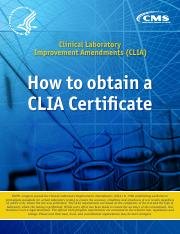Learn how to obtain a Clinical Laboratory Improvement Amendments (CLIA) certificate. This detailed guide covers requirements, steps, and key checklist points for clinical labs.
Clinical Testing: Any lab performing clinical testing should be on a path to getting a Clinical Laboratory Improvement Amendments (CLIA) certificate. This article will help walk you through the tedious steps of how to get a CLIA certificate and what are the requirements and key checklist points. for the road to CLIA certification.
What is CLIA Certification?
Why CLIA Certification is Important: CLIA certification helps clinical laboratories meet quality standards and proficiency requirements so that their test results are accurate and reliable.
Centers for Medicare and Medicaid Services (CMS): The CMS is an agency within the US federal government responsible for administering and overseeing much of the CLIA program, including certification as described below.
Understand the Complexity Level of Your Lab:
CLIA Complexity Categories: Laboratories are rated as waived, moderate complexity or high complexity based on the type of tests they perform. Choose the appropriate level for your lab to know the specifications it must meet.
Sow the Documentation and Quality Systems
Standard Operating Procedures (SOPs):
Develop a strong Quality Management System that remains compliant to CLIA standards. This may involve creating processes related to documentation, training, testing for competency, equipment calibration and quality assurance.
Personnel and Training Needed:
Establish Personnel Qualifications: Determine the required qualifications and competency requirements for individuals working based on the complexity level of your laboratory.
Development of facility-specific training programs to ensure that all laboratory personnel are trained on SOPs, safety regulations, quality control, and regulatory compliance.
Proficient Testing and Quality Control:
Unfortunately, many labs do not participate in proficiency testing program that evaluates the laboratory’s ability to produce accurate and reliable test results.
Perform Quality Control: Develop strategies to perform complete quality control procedures to measure test result accuracy and precision.
Overview of The Process for CLIA Application and Inspection
Submit CLIA Application: Fill out the CLIA application form and send it to CMS with all required information about your laboratory, personnel, testing procedures, and quality systems.
Inspection: CMS or an approved accreditation organization will inspect firms to ensure compliance with CLIA regulations. To be prepared for inspection, make sure that all the documentation, quality systems and personnel qualifications are according to standard.
CLIA Certified Staff Maintenance
Running: Monitoring CLIA regulations for adherence and remaining compliant with proficiency testing participation, quality control assessments, documentation updates.
Periodic Inspections: Regular inspections for ongoing CLIA compliance and adherence to CLIA guidelines
A CLIA certificate is a major achievement for any lab that conducts clinical testing.patient-focused It is important to remember that CLIA certification cannot be claimed as a one-time accomplishment. It requires the continuous effort of maintaining quality, proficiency, and compliance. The benefits of CLIA certification keep your laboratory patient focus and help advance healthcare.
Conclusion
The process of obtaining a CLIA certification may change over time, so the information can be best understood by BioBoston consulting from the official guidelines or regulations offered through CMS (Centers for Medicare and Medicaid Services).


